Dovetails smuvtails! Every woodworking blog I read raves about dovetails. Dovetail this, dovetail that, fast dovetails, no-measure dovetails, 7 degree dovetails, 11 degree dovetails. Gheesh, you’d think woodworking revolves around dovetails. C’mon folks. Go take a close look at real 18th century furniture and the quality of dovetails in that stuff. The pre-machine era dovetails were a far distance from the holy grail woodworkers pursue today. Most of them were semi-hidden anyway, not as prominently featured as today. OK, rant over.
I don’t build furniture, so I’ve never felt compelled toward dovetail perfection. Then, along comes this plan that shows a tool rest held together with what? A dovetailed joint. Yes, I practiced a bit and did more than the one shown here. I’m happy getting it to look a bit better than Dave Letterman’s front teeth. It is a surprisingly solid join. No wiggle! This particular part of the lathe is very close to the plan, except for part thickness. The plan calls for full inch stuff, which I don’t have and did not want to go get. I did upgrade from constriction fir to red oak for the rest and the clamping collar. I’m using simple fir for the wedges, seeing them as sacrificial. This rest has a fair degree of movement and positioning capability. The plan shows a hole in the far end of the horizontal piece, which is intended to hold a bolt upon which a face rest can be built. I’ve skipped that for now.
OK Ralph. The first real turning is a good drive pulley/wheel to replace that fence finial.
The challenge was to make a piece with a 5/8″ axial hole. Having neither a jawed chuck to hold a turned piece, nor a way to feed a drill bit along the center line, I improvised. The turning block comes from a section of laminated material identical to the lathe feet, essentially a pair of 2x4s, about 7 inches long. I drilled a 5/8″ hole through the center of the block with an auger bit, being careful to just pierce the far end with the lead screw. That small hole in the far end served as a centering point for the spur drive bit.
A live center slipped into the end of the block with the start of the 5/8″ hole. Then, came the bit of the old fogie learning to hop about on one leg whilst pumping the treadle with the other and trying to learn how to manage turning tools while bouncing, swaying, and fighting off vertigo. My wife stopped by to watch and snicker for a few minutes, and fortunately got bored and left.
I messed about quite a while trying out several new Wood River turning tools. As an aside, these tools arrive needing a good honing. Actually that’s not difficult, and once honed they seem to work well. Yet, I’m a novice turner and anything that can change the shape of the wood impresses me.
Yes, I made a variety of “interesting” surfaces along the way. My best work was with a 1/2″ roughing gouge. My worst, of course, with the skew. I don’t yet have a parting gouge, so ended up hand sawing the ends away.
The temporary ball pulley/wheel demonstrated the value of a crested surface in helping keep the belt running nicely. So, I made this piece with a crest, although not as extreme as the temporary part. I decided to use the same simple mounting, a screw through the wheel into a hole in the spindle. The wheel ends up a bit smaller than the earlier part, requiring the belt to be shortened a bit and restitched.
The first turning can be called mostly a success. Mostly because even though it was round while between centers, it is not perfectly round when mounted on the spindle. As careful as I was in the improvising, the spindle hole did not get perfectly mounted between centers. I suspect it is due to “play” in positioning the tail puppet. I’ll have to learn how to make that more precise.
Now, I’m like the dog that caught the car. What next?
Lastly, a few words for Kari: Here’s a lathe you can like. Human power can’t get it turning fast enough to hurl heavy objects at your head. If/when you catch the point of a skew chisel, there’s not enough momentum to grab the chisel out of your hands and throw it back at you. Instead, the belt slips until you easily regain control. In short, it is a non-lethal lathe.
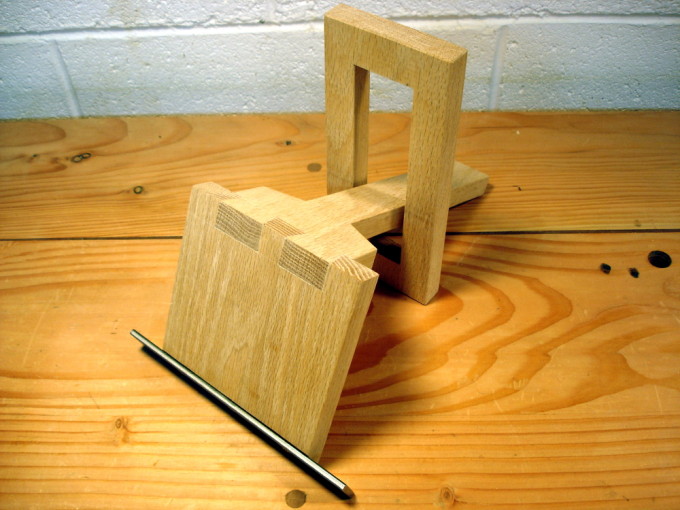
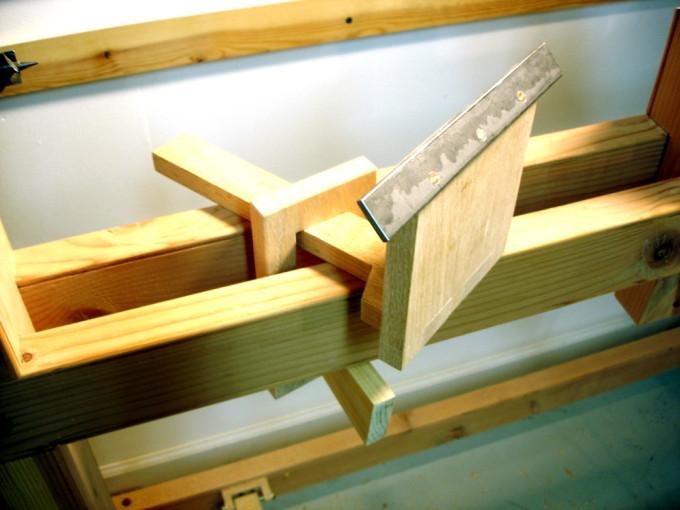
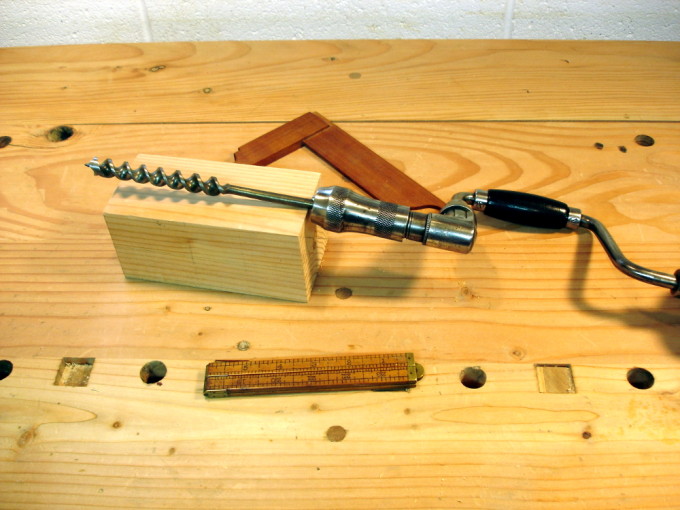
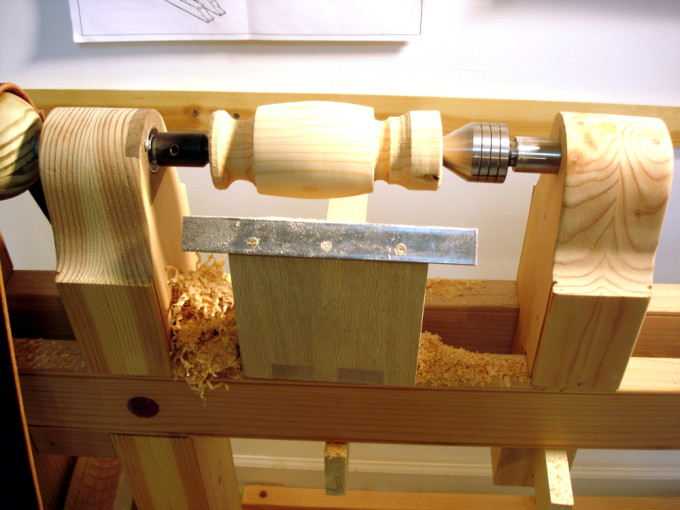
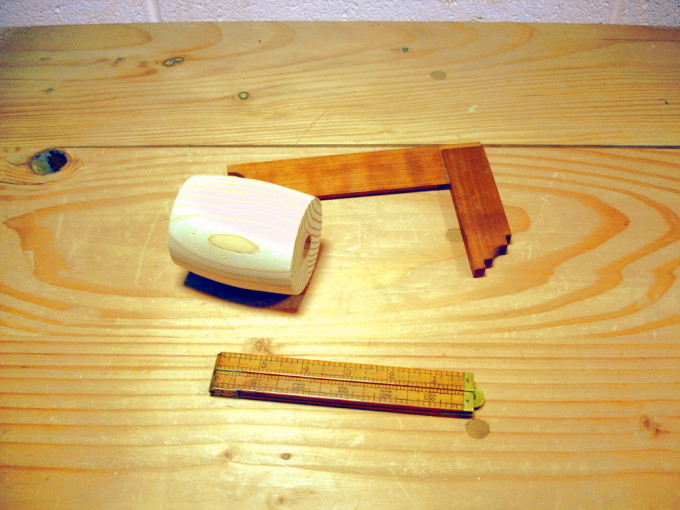
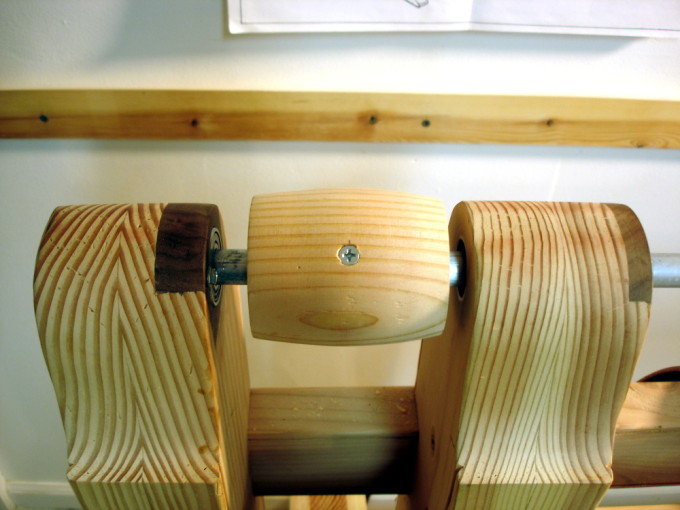
Hi Bob,
I wouldn’t consider a part made for the lathe to be a “first project”. Once the lathe is complete – then you call it your first project. I like the fit you got on the dovetails for your tool rest. And I agree that dovetails are more “artsy” then a good joint to bring two pieces of wood together at 90 degrees.
ralph
Looks like a challenging project! Going to be another very useful choclate powered tool!
Yep! That’s the only reason I built it … as an excuse for more chocolate!
Looking good Bob. I admit to being dubious of no tension idler pulley but seeing this pulley come out I’m rethinking that “extra”. From your note to Kari (Sawstop of lathes?) it sounds like you did encounter some slippage. I don’t think you could ever eliminate slipping but I am hoping to minimize it enough so I can add an arbor and cross for faceplate style turning. I imagine the torque from a turning 4×4 is a wee bit less than a 24″ pedestal table top run on the outboard side of the headstock. I’ll be curious to see if the slippage cause you any issues as you start to turn more.
Shannon,
Yes, there’s some slippage, but only when I really “jam it” with a stupid chisel move. There’s plenty of torque to make cuts I really didn’t want to make. 🙂
That’s with almost know stretch to getting the belt over the wheels. It’s notably slack. I attribute the good performance to width. There’s a lot of contact area.
There might be some faceplate work in the future, but definitely not 24″ table tops. If I really wanted to do that sort of work, I would have built a very different lathe. I saw one recently on YouTube, but didn’t bookmark it, which was a treadle lathe spinning a large flywheel and chuck that directly faces the ways / tool rest. The treadling mechanism had a ratcheting clutch. Pump like crazy and do the cutting while the momentum coasts. Very heavy duty.
Otherwise, I’m thinking about one of these. 🙂